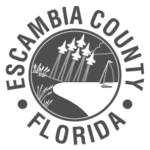For the most up-to-date red Red Tide status information, please check FWC's Current Statewide Status report.
In Florida "red tide," or harmful algal bloom, is a higher than normal concentration of a naturally occurring microscopic alga, or plant-like microorganism, called Karenia brevis or K. brevis. K. brevis produces brevetoxins that can affect the central nervous system of fish and other vertebrates, causing these animals to die. Large concentrations, called blooms, can change the water color to red, light or dark green, or brown, giving the blooms the name "red tide." Escambia county staff send samples of local waters for testing each week.
Red tides occur all over the world. No single factor causes a red tide. K. brevis is found almost exclusively in the Gulf of Mexico but has been found on the east coast of Florida and off the coast of North Carolina. Red tide blooms can last days, weeks or months and can change daily due to wind conditions and water currents. Onshore winds normally bring it near the shore, and offshore winds drive it out to sea.The Florida red tide can be found in bays and estuaries but not in freshwater systems such as lakes and rivers. Because K. brevis cannot tolerate low-salinity waters for very long, blooms usually remain in salty coastal waters and do not penetrate upper reaches of estuaries. However, other harmful algae, including cyanobacteria (blue-green algae), typically bloom in freshwater lakes and rivers.
Red tides can last as little as a few weeks or longer than a year. They can even subside and then reoccur. The duration of a bloom in nearshore Florida waters depends on physical and biological conditions that influence its growth and persistence, including sunlight, nutrients and salinity, as well as the speed and direction of wind and water currents.
Impacts to People
Some people who swim in water with red tide may experience skin irritation and eye irritation. If this happens, thoroughly wash with fresh water. Wave action can break open
K. brevis cells and release these toxins into the air, leading to respiratory irritation. For most people, these are temporary symptoms. Wearing a particle mask and using antihistamines can help with symptoms. For people with severe or chronic respiratory conditions, such as emphysema or asthma, red tide can cause serious illness. If you have a chronic respiratory problem like severe asthma, be careful near red tide areas, and check current marine conditions. It is good practice for many reasons not swim in areas where there are dead fish in the water, including when a red tide is present. If you are having medical issues, please contact your primary care physician or call 9-1-1 for all emergencies.
SeafoodThe red tide toxins can also accumulate in molluscan filter-feeders such as oysters and clams, which can lead to Neurotoxic Shellfish Poisoning in people who consume contaminated shellfish. It is important to note that safeguards are in place and
commercial seafood purchased in restaurants, grocery stores and seafood markets is safe to eat.
However, recreationally caught fish are not checked by health officials. If catching your own fin or shellfish, please follow these guidelines:
- Clams, scallops and oysters can contain red tide toxins that cause Neurotoxic Shellfish Poisoning. Check local harvesting status before collecting at FreshFromFlorida.com.
- Finfish caught live and healthy can be eaten if filleted and rinsed thoroughly.
- Edible meat of crabs, shrimp and lobsters can be eaten but do not eat the tamalley — the green digestive gland — of shellfish.
- Do not eat distressed animals or animals found dead under any circumstances.
- For current red tide conditions, go here.
